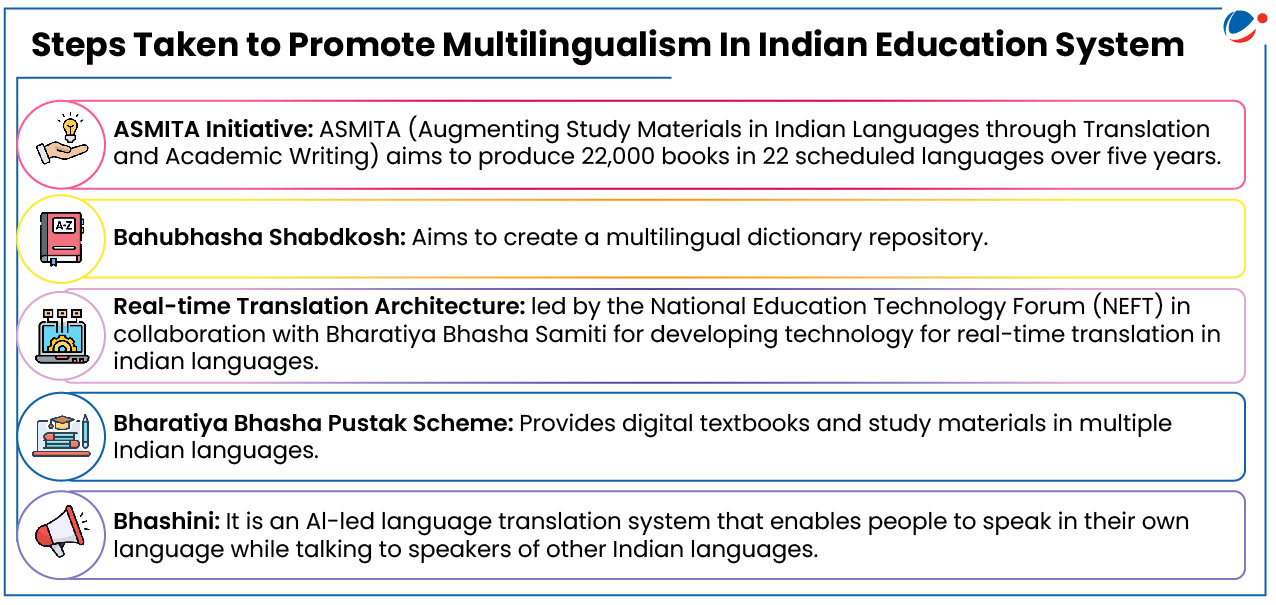Why in the news?
In some states there have been opposition of National Education Policy (NEP) 2020's three-language formula.
About NEP and Three Language Formula
- NEP 2020 Policy: Requires students to learn three languages, with at least two being Indian.
- Changes from Past Policies: Unlike the NEP 1968, which mandated Hindi, English, and a regional language, NEP 2020 allows flexibility in language selection.
- Regional Flexibility: States and students can choose languages, promoting multilingualism while respecting cultural and regional diversity.
Evolution of Three Language Formula Policy
|
Advantages of Three Language Formula
According to UNESCO's latest report Languages Matter: Global Guidance on Multilingual Education, multilingual education
- Enhances Access and Inclusion
- Wider educational access: Helps children from diverse linguistic backgrounds learn in a language they understand.
- Parental engagement: Learning in native languages boosts parental involvement in education.
- Inclusion of marginalized groups: Respects and integrates linguistic and cultural diversity in education.
- Improves Learning Outcomes
- Nurturing Socio-emotional growth: Multilingual education helps children express themselves better and understand diverse perspectives.
- Better academic performance: Research shows multilingual students excel in other subjects due to enhanced cognitive abilities.
- Supports Sustainable Development
- Cultural preservation: Protects languages and traditions for future generations.
- Economic benefits: E.g. Switzerland attributes 10% of its GDP to its multilingual heritage.
- Social harmony: Encourages understanding and tolerance between linguistic and cultural groups.
- Environmental protection: Indigenous languages preserve traditional knowledge and sustainable practices.
- Facilitates National Integration
- Effective communication: Helps students interact across regions.
- Unity in diversity: Promotes respect for different cultures and languages, strengthening national identity.
Arguments Against Three-Language Formula
- Politicisation: Language is a politically sensitive issues in many part of the world. Multilingual education could be used as a tool to mobilise people in spirit of the 'sons of the soil' which may hamper national integrity.
- Sons of the soil are culturally dominant in their region but a minority in the country. They feel threatened by migrants from the majority culture settling in their homeland.
- Language Learning Should be a Choice: Adults can learn languages based on their profession and other needs, making compulsory school language policies unnecessary.
- Struggles in Primary Education: Many students in India lack basic literacy. Adding a third language could overburden an already strained education system.
- Additionally, Children from monolingual homes may find multilingual education confusing and stressful.
- Shortage of Qualified Teachers: Shortage of teachers for 2nd and 3rd language could divert funds from more pressing educational needs like infrastructure for faculty training.
- Challenges for Linguistically Diverse States: States like Nagaland, with multiple languages and limited resources, may struggle to implement a three language formula.
- Execution difficulties: For example, Haryana introduced Tamil but faced difficulties.
- Technology Reduces Barrier: AI tools like Google Gemini provide instant translations, making language proficiency less necessary.

Way Forward for Effective Implementation of Three Language Formula
- Prioritizing Education Quality: Focus on improving teaching quality and learning outcomes rather than adding more languages.
- Strengthening Cooperative Federalism: Encourage dialogue between the Centre and States to ensure smooth NEP 2020 implementation and avoid funding delays.
- Aligning with UNESCO's Multilingual Education Guidance
- Data-Driven Policy: Collect sociolinguistic and educational data for effective planning.
- Learning Materials & Assessments: Develop resources in learners' languages and adapt assessments.
- Qualified Teachers: Train educators fluent in both the mother tongue and official language.
- Community Engagement: Involve parents, caregivers, and Indigenous groups in designing effective multilingual programs.



